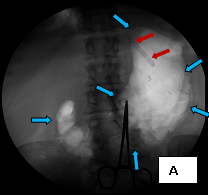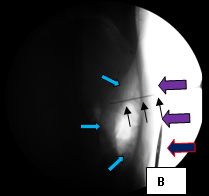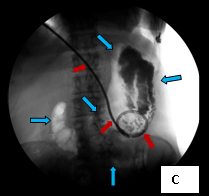Sometimes feeding a patient by mouth is impossible or contraindicated, and providing them adequate nutrition becomes a challenge. Substituting oral nutrition with parenteral (intravenous) nutrition is fine when temporary, but not when prolonged; it has its own challenges and complications.
In such a situation, a patient can receive a gastrostomy or gastrojejunostomy feeding tube. Providing such feeding accesses involves the insertion of a feeding tube into the stomach (gastrostomy) or into the upper small intestine, the jejunum, through the stomach (gastrojejunostomy). In both cases the catheter placement is through the skin (percutaneous). The pre- and post-procedure care of these patients is simple and the tube may be put to use within 24 hours, barring complications.



These three images illustrate a variation of how I perform percutaneous gastrostomy. Image A (supine frontal fluoroscope of the upper anterior abdomen) shows gastric insufflation after temporary gastroparesis with intravenous glucagon – distention of the stomach with air (the blue arrows outline the distended stomach) – through a nasogastric tube inserted into the stomach through the nose (the red arrows). The purpose of distending the stomach with air is to bring the anterior wall of the stomach against the anterior abdominal wall, which facilitates passing instruments of the procedure from the outside into the stomach. This is shown in Image B (a cross-table lateral fluoroscope of the upper abdomen) in which the light blue arrows outline part of the air-filled stomach; the purple arrows mark out the skin of the abdomen on which lies a pair of scissors, identifying the skin (the deep blue arrow with red outline); the black thin arrows indicate a 16 gauge needle passing from the surface of the skin into the lumen of the stomach. Image C (also a supine frontal fluoroscope of the abdomen) shows the deployed feeding tube (red arrows) within the stomach (light blue arrows).
Percutaneous gastrostomy is quick and safe, typically requiring conscious sedation and the use of local anesthetic to do. Proper care of the access requires adequate flushing of the tube after each use, preferably with fizzy drinks (carbonated beverages), good grinding of pills before administering them through the tube to prevent blockage of the tube, and meticulous attention to the skin around the opening into the catheter track to prevent infection.



